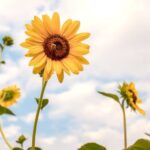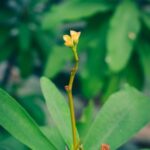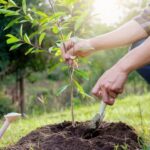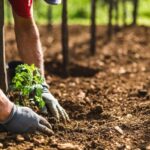Are you looking for bog garden ideas to add a unique and beautiful element to your outdoor space? Bog gardens, also known as wetland gardens, are a wonderful way to create a natural and sustainable habitat for plants, wildlife, and conservation efforts.
In this article, we will explore the benefits of building a bog garden, how to choose the right location, essential materials and tools needed, selecting the best plants, design and layout ideas, maintenance tips, creative features, and incorporating wildlife and conservation into your bog garden.
Bog gardens offer numerous benefits for both the environment and the gardener. By creating a bog garden in your yard or outdoor space, you can promote biodiversity, provide essential habitat for wildlife such as frogs, birds, and insects, conserve water resources, and reduce erosion. Additionally, a well-designed bog garden can be an attractive and low-maintenance addition to any landscape.
Choosing the right location for your bog garden is crucial to its success. Whether it’s in full sun or partial shade, considering factors like drainage patterns and proximity to natural water sources is important. In the following sections of this article we’ll explore how to identify the best location for your bog garden based on these considerations.
Benefits of Creating a Bog Garden
Creating a bog garden offers numerous benefits for both the environment and the gardener. One of the primary advantages is its ability to support a wide range of plant and animal species, including some that may be unique to wetland areas.
This can contribute to biodiversity in your local ecosystem and provide habitat for wildlife such as frogs, dragonflies, and various bird species. Additionally, bog gardens can enhance water conservation efforts by absorbing excess rainwater and preventing runoff, which helps to mitigate flooding and erosion.
Furthermore, bog gardens are relatively low-maintenance once established, as they require minimal watering and fertilization. This makes them an ideal option for busy gardeners or those looking to reduce their environmental impact. In terms of aesthetics, a well-designed bog garden can add beauty and interest to any landscape with its lush foliage, vibrant colors, and unique textures. It can also serve as a focal point or conversation piece in your outdoor space.
Moreover, creating a bog garden provides an opportunity to learn about different types of wetland plants and their ecological roles. It allows you to connect with nature on a deeper level while contributing to important conservation efforts. By choosing the right plant species for your bog garden, you can help preserve native flora and create a sustainable habitat that supports various life forms.
| Benefits | Details |
|---|---|
| Biodiversity | Supports diverse plant and animal species |
| Water Conservation | Absorbs rainwater and prevents runoff |
| Low-Maintenance | Requires minimal watering and fertilization |
| Educational Opportunity | Learn about wetland plants and conservation |
Choosing the Right Location for Your Bog Garden
When it comes to creating a bog garden, choosing the right location is crucial for the success of your project. Whether you are planning to build a small-scale bog garden or a larger one, selecting the perfect spot can significantly impact the overall health and growth of your plants. Here are some essential factors to consider when deciding on the location for your bog garden:
Sunlight and Shade
The amount of sunlight and shade in the chosen location is an important consideration when creating a bog garden. Most bog plants thrive in partial shade, so look for an area that receives dappled sunlight throughout the day. Ideally, a location that gets morning sun and afternoon shade would be perfect for most bog plants.
Water Source
Since bog gardens require consistently moist soil, proximity to a water source is vital. Consider locating your bog garden near a natural water source such as a stream, pond, or wetland. If this is not possible, ensure that your chosen spot is easily accessible for regular watering.
Soil Drainage
One of the most critical aspects of selecting a site for your bog garden is soil drainage. You’ll want to choose an area with poor drainage where water tends to pool or sit after rain. This ensures that the soil will stay consistently moist without becoming waterlogged.
By carefully considering these factors when choosing the right location for your bog garden, you can create an optimal environment for the growth and flourishing of your bog plants. With these key considerations in mind, you’ll be well on your way to establishing a thriving and beautiful bog garden in your own backyard.
Essential Materials and Tools for Building a Bog Garden
When it comes to building a bog garden, having the right materials and tools is essential for creating a successful and thriving wetland habitat. The key to a successful bog garden lies in creating the perfect growing environment for moisture-loving plants. To achieve this, there are specific materials and tools that are necessary for building a thriving bog garden.
One of the essential materials needed for building a bog garden is a waterproof liner or pond liner. This will help to retain the water that is necessary for creating the wet conditions that bog plants thrive in. Additionally, you will need to consider the type of soil you use in your bog garden. A mix of peat moss, sand, and perlite is often recommended to create the ideal growing medium for bog plants.
In terms of tools, some essential items include a shovel for digging out the area where your bog garden will be located, as well as a rake for leveling the soil and removing any debris or rocks. It’s also important to have access to water nearby for filling up your bog garden once it’s been constructed.
With these essential materials and tools in place, you’ll be well-equipped to start building your own beautiful and flourishing bog garden.
Overall, when it comes to creating a successful and thriving bog garden, having access to the right materials and tools is crucial. By carefully selecting the appropriate liner, soil mix, and using essential tools such as shovels and rakes, you will be on your way towards creating a stunning wetland habitat that will provide an ideal home for moisture-loving plants while enhancing the beauty of your outdoor space.
Selecting the Best Plants for Your Bog Garden
When it comes to selecting the best plants for your bog garden, there are plenty of options to choose from. The key is to find species that can thrive in the unique conditions of a bog, such as wet soil and fluctuating water levels. Here are some plants that are ideal for creating a thriving and beautiful bog garden:
- Pitcher Plants: These carnivorous plants thrive in boggy areas and add a unique and exotic touch to your garden.
- Marsh Marigold: This vibrant yellow flower is a classic choice for bog gardens, adding a pop of color to the wet landscape.
- Cattails: These tall, reed-like plants are perfect for adding height and texture to your bog garden, while also providing habitat for wildlife.
- Blue Flag Iris: With striking blue-purple flowers, this iris is well-suited for the moist conditions of a bog garden.
In addition to these specific plant suggestions, it’s important to choose a diverse selection of flora to create a balanced ecosystem within your bog garden. Look for plants that provide food and shelter for wildlife, such as dragonflies, frogs, and birds. By incorporating a variety of plant species, you can enhance the ecological value of your bog garden while also creating an aesthetically pleasing landscape.
Whether you’re interested in constructing a small-scale bog garden in a container or transforming a larger area of your yard into a wetland paradise, choosing the right plants is essential for success. Be sure to research the specific growing requirements of each plant species you select to ensure they will thrive in the unique conditions of your bog garden.
With careful planning and thoughtful selection, you can create a stunning and sustainable oasis with an array of beautiful plants that will flourish in their waterlogged environment.
Design and Layout Ideas for Bog Gardens
When it comes to designing and laying out your bog garden, there are several key factors to consider in order to create a visually appealing and functional space. Here are some ideas to help you get started:
Incorporate Different Levels and Textures
One of the most effective ways to create visual interest in your bog garden is by incorporating different levels and textures. You can achieve this by using a variety of plants with different heights, shapes, and foliage textures. Consider incorporating taller plants towards the back of the garden, with medium-sized plants in the middle, and low-growing plants at the front. This layering technique creates depth and dimension in your garden.
Add a Water Feature
Since bog gardens thrive in wet conditions, consider adding a small water feature to your design. A shallow pond or stream can provide additional moisture for your bog-loving plants while adding an element of tranquility to your garden. You can also incorporate aquatic plants such as water lilies or floating ferns to enhance the aesthetic appeal of the water feature.
Create Pathways and Seating Areas
To fully enjoy your bog garden, consider creating pathways that allow you to navigate through the space easily. These pathways can be made with gravel, stepping stones, or wooden boardwalks, depending on the overall aesthetic you want to achieve. Additionally, incorporating seating areas within your bog garden will encourage you to spend more time enjoying its beauty and observing wildlife that may be attracted to the area.
By carefully considering these design and layout ideas for your bog garden, you can create a beautiful and functional space that not only enhances your outdoor landscape but also provides valuable habitat for wildlife.
Maintenance and Care Tips for Bog Gardens
Once you have established your bog garden, it is essential to provide regular maintenance and care to ensure the health and beauty of this unique ecosystem. Here are some tips to help you maintain your bog garden:
1. Watering: While bog gardens thrive in moist conditions, they still require consistent watering, especially during dry spells. Be sure to keep the soil consistently moist, but not waterlogged, to support the plants’ growth and vitality.
2. Weeding: Regular weeding is crucial to prevent invasive plants from taking over your bog garden. Be mindful of any non-native species that may threaten the balance of your ecosystem and remove them promptly.
3. Fertilization: Avoid using chemical fertilizers in your bog garden, as they can disrupt the natural balance of the wetland environment. Instead, incorporate organic matter such as compost or well-rotted manure to provide essential nutrients to your plants.
In addition to these tasks, it is important to regularly monitor the overall health of your bog garden and make adjustments as needed. By staying attentive and proactive in caring for your bog garden, you can create a thriving and sustainable wetland habitat that will bring joy and environmental benefits for years to come.
| Maintenance Tasks | Care Tips |
|---|---|
| Watering | Keep soil consistently moist without waterlogging |
| Weeding | Regularly remove invasive plants |
| Fertilization | Avoid chemical fertilizers; use organic matter instead |
Creative and Functional Features for Your Bog Garden
When it comes to creating a bog garden, there are many creative and functional features that can enhance the beauty and functionality of your space. Whether you want to add a focal point or incorporate elements that attract wildlife, there are plenty of ideas to consider. Here are some suggestions for adding creative and functional features to your bog garden:
1. Water Features: Adding a small pond or water feature can not only enhance the aesthetic appeal of your bog garden but also provide a habitat for amphibians and other wildlife. Consider incorporating a small waterfall or stream to create movement and interest.
2. Pathways and Bridges: Create pathways using stepping stones or wooden planks to allow access to different areas of your bog garden while adding visual interest. You can also include bridges over small streams or water features to connect different parts of the garden.
3. Birdhouses and Feeders: Encourage birds and other wildlife to visit your bog garden by incorporating birdhouses and feeders. This not only adds visual appeal but also supports local biodiversity.
4. Benches or Seating Areas: Create a relaxing space within your bog garden by including benches or seating areas where you can sit back and enjoy the beauty of the surroundings.
5. Raised Planting Beds: Consider adding raised planting beds to showcase specific plant species or create varying levels within your bog garden for added visual interest.
By including these creative and functional features in your bog garden, you can elevate its aesthetic appeal while providing additional benefits for wildlife and conservation efforts in your area. Whether you choose one feature or several, each addition can contribute to the overall beauty and functionality of your bog garden, making it a truly unique outdoor space.
Incorporating Wildlife and Conservation Into Your Bog Garden
Creating a bog garden is not only a beautiful addition to your outdoor space, it also provides an opportunity to incorporate wildlife and contribute to conservation efforts. By intentionally designing your bog garden with the needs of local wildlife in mind, you can create a thriving ecosystem that supports biodiversity and conservation.
One of the key elements in incorporating wildlife into your bog garden is selecting native plant species that attract and support local wildlife. Native plants provide food and shelter for insects, birds, amphibians, and other small animals, effectively creating a mini-ecosystem within your bog garden. Consider including plants such as pitcher plants, sundews, wild irises, and ferns to attract pollinators and provide habitat for small creatures.
In addition to plant selection, design features such as shallow water areas or small ponds can create valuable water sources for wildlife. Incorporating rocks or logs can provide basking spots for turtles or resting places for amphibians. By creating these diverse habitats within the bog garden, you can help support local wildlife populations while also contributing to conservation efforts in your area.
Another way to enhance the wildlife value of your bog garden is by installing bird feeders or nesting boxes nearby. These features attract birds and provide them with essential resources throughout the year.
Additionally, maintaining a pesticide-free environment within your bog garden will ensure that beneficial insects thrive and contribute to the overall health of the ecosystem. Incorporating these wildlife-friendly elements into your bog garden not only enhances its beauty but also makes a positive impact on local conservation efforts.
Conclusion
In conclusion, bog gardens are a unique and valuable addition to any outdoor space. Not only do they provide a diverse and beautiful array of plants, but they also offer essential habitat for wildlife and play a crucial role in conservation efforts. By creating a bog garden, you are not only enhancing the beauty of your garden but also contributing to the preservation of important ecosystems.
As we have discussed throughout this article on bog gardens ideas, there are numerous benefits to creating a bog garden. From providing a habitat for important pollinators and amphibians to improving water quality and reducing erosion, bog gardens offer a wide range of environmental advantages. In addition, these gardens can be an excellent way to educate others about the importance of wetland habitats and encourage conservation efforts in your community.
When considering bog garden designs and layouts, it is important to carefully select the right plants and materials that will thrive in wet conditions. Whether you choose to incorporate water features or create meandering paths through your bog garden, there are endless opportunities for creativity and functionality.
By following maintenance and care tips, incorporating wildlife-friendly features, and embracing the natural beauty of these wetland environments, you can create a stunning and beneficial bog garden that will enrich your outdoor space for years to come.
Frequently Asked Questions
How Do You Start a Bog Garden?
To start a bog garden, you need to choose a suitable location with moist soil and partial shade. Create a liner to retain water, add a layer of coarse sand or gravel, then top it off with acidic, nutrient-poor soil.
Are Bogs Good for Gardening?
Bogs can be great for gardening if you want to grow plants that thrive in wet, acidic conditions. They provide a unique environment for cultivating beautiful and unusual plant species like carnivorous plants and colorful bog flowers.
What Is the Best Soil Mix for a Bog Garden?
The best soil mix for a bog garden is one that mimics the natural conditions found in bogs. This typically includes a mixture of peat moss, coarse sand, and perlite or vermiculite to improve drainage. You’ll also want to make sure the soil mix is acidic, with a pH between 4 and 6.

Welcome to my gardening blog! I am passionate about plants and enjoy sharing my knowledge and experiences with others. In this blog, I will write about everything related to gardening, from tips on how to get started to updates on my own garden projects.





